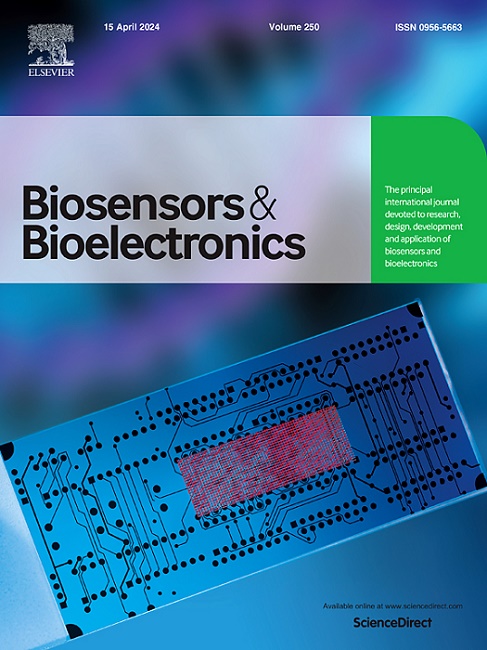Ultrasensitive dual-mode biosensor for photoelectrochemical and differential pulse voltammetry detection of thrombin based on DNA self-assembly
IF 10.7
1区 生物学
Q1 BIOPHYSICS
引用次数: 0
Abstract
Abnormal levels of thrombin may be associated with various diseases, such as thrombosis and hemorrhagic diseases, making precise detection of thrombin particularly important. Dual signal detection is a method that enhances detection sensitivity and specificity by simultaneously utilizing two different signals. Its primary advantages include improving detection accuracy and reducing false positive rates, making it particularly suitable for clinical analysis and diagnostics. In this work, we developed a dual signal detection method for thrombin based on DNA self-assembly. This design incorporates an X-DNA structure. The two bottom arms of the X-shaped DNA (X-DNA) are designed to bind to CuInS2 nanoparticles via dehydration reactions between amine and carboxyl groups. The two top arms of the X-DNA are designed to hybridize with complementary DNA/glucose oxidase (GOx) and DNA/ferrocene (Fc), respectively. Thrombin triggers the hybridization of DNA/GOx and X-DNA, simultaneously causing the dissociation of DNA/Fc from X-DNA. In the Photoelectrochemical mode, GOx can react with O2 and glucose in the detection solution, resulting in a corresponding decrease in the amount of O2 acting as an electron acceptor and a decrease in the photoelectric signal. In the Differential Pulse Voltammetry mode, due to the decrease in Fc content, the DPV signal also shows a weakening trend. The detection method exhibits a good linear relationship within the range of 10 fM −10 nM, with a detection limit of 6.89 fM and 5.86 fM. The enhanced analytical sensitivity and specificity of dual signal detection technology offer broad prospects for improving disease diagnosis.

基于DNA自组装的用于光电化学和差分脉冲伏安法检测凝血酶的超灵敏双模生物传感器。
凝血酶水平异常可能与多种疾病有关,如血栓形成和出血性疾病,因此凝血酶的精确检测尤为重要。双信号检测是一种通过同时利用两种不同的信号来提高检测灵敏度和特异性的方法。它的主要优点包括提高检测准确性和减少假阳性率,使其特别适用于临床分析和诊断。在这项工作中,我们开发了一种基于DNA自组装的凝血酶双信号检测方法。这个设计包含了一个X-DNA结构。x形DNA (X-DNA)的两个底部臂被设计为通过胺和羧基之间的脱水反应与CuInS2纳米颗粒结合。X-DNA的两个上臂分别用于与互补DNA/葡萄糖氧化酶(GOx)和DNA/二茂铁(Fc)杂交。凝血酶触发DNA/GOx和X-DNA的杂交,同时引起DNA/Fc与X-DNA的分离。在光电化学模式下,GOx可以与检测溶液中的O2和葡萄糖发生反应,导致作为电子受体的O2数量相应减少,光电信号减弱。在差分脉冲伏安模式下,由于Fc含量的降低,DPV信号也呈现出减弱的趋势。检测方法在10 fM -10 nM范围内呈良好的线性关系,检测限分别为6.89 fM和5.86 fM。双信号检测技术提高了分析灵敏度和特异性,为改善疾病诊断提供了广阔的前景。
本文章由计算机程序翻译,如有差异,请以英文原文为准。
求助全文
约1分钟内获得全文
求助全文
来源期刊

Biosensors and Bioelectronics
工程技术-电化学
CiteScore
20.80
自引率
7.10%
发文量
1006
审稿时长
29 days
期刊介绍:
Biosensors & Bioelectronics, along with its open access companion journal Biosensors & Bioelectronics: X, is the leading international publication in the field of biosensors and bioelectronics. It covers research, design, development, and application of biosensors, which are analytical devices incorporating biological materials with physicochemical transducers. These devices, including sensors, DNA chips, electronic noses, and lab-on-a-chip, produce digital signals proportional to specific analytes. Examples include immunosensors and enzyme-based biosensors, applied in various fields such as medicine, environmental monitoring, and food industry. The journal also focuses on molecular and supramolecular structures for enhancing device performance.
 求助内容:
求助内容: 应助结果提醒方式:
应助结果提醒方式:


